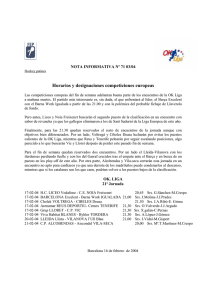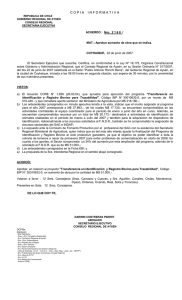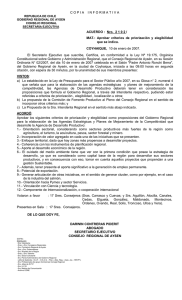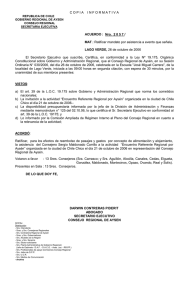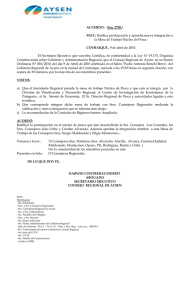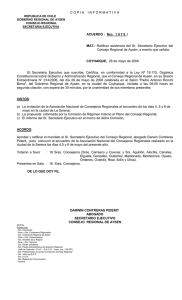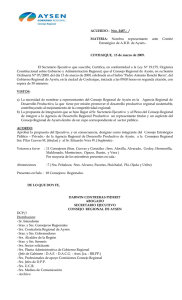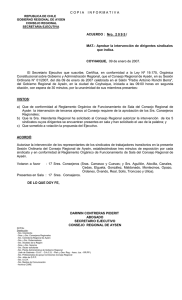ENFOQUE MULTIDISCIPLINAR EN EL paciente con
Anuncio
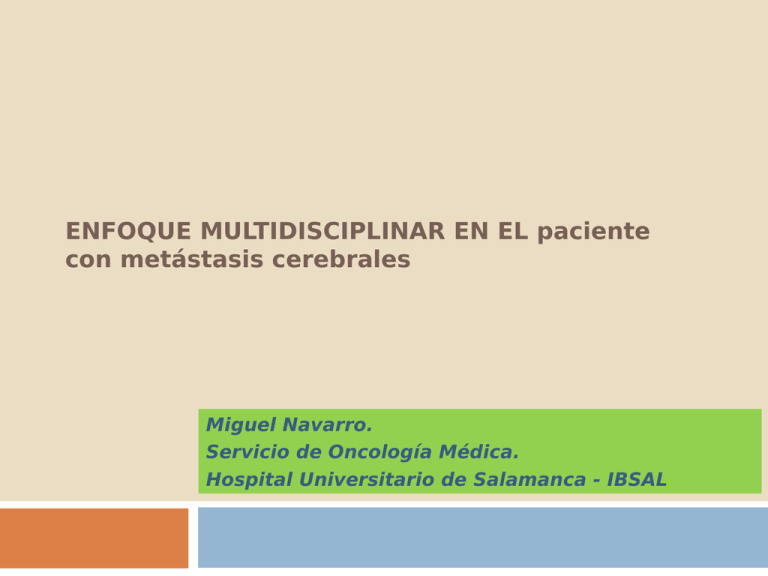
ENFOQUE MULTIDISCIPLINAR EN EL paciente con metástasis cerebrales Miguel Navarro. Servicio de Oncología Médica. Hospital Universitario de Salamanca - IBSAL Introducción Dosis única elevada Problema ↑ ¿Cambios!! Evento tardío Nihilismo? Síntomas Santuario Manejo terapéutico. SOPORTE QTI ¿nuevos fármacos? TRATAMIENTO MULTIDISCIPLINAR RDT RDCx CIRUGÍA ¿Qué factores pronósticos son importantes para la evaluación y el manejo de pacientes con metástasis cerebrales ? Tratamiento soporte (corticoides) 1-2 meses Edad Performance status Primario Extensión extracraneal Nº de Mtx Cerebrales Recursive Partitioning Analysis (RTOG) • No diagnóstico especifica. • Anticuada RTOG. 3 grupos. Basada 1200p tratados con WBRT +/- radiosensibilizantes (19791993) IK EDAD EXTENSIÓN Supervivenci a GRUPO 1 > 70 <65 años Primario controlado No mts extracerebrales 7,1 meses GRUPO 2 >70 >65 años Primario no controlado Mts extracerebrales 4,2 meses GRUPO 3 <70 2,3 meses Gaspar LE, et al. Recursive partitioning analysis (RPA) of prognostic factors in three Radiation Therapy Oncology Group (RTOG) brain metastases trials. Int J Radiat Oncol Biol Phys. 1997; 37:745. Graded Prognostic Assessment 0 PUNTOS 0,5 PUNTOS 1 PUNTO EDAD >60 años 50-59 años <50 años IK <70 70-80 90-100 Nº MTS SNC >3 2-3 1 MTS EXTRACRANEALES Presentes - Ausentes Updated era (19852007) PUNTUACIÓN SUPERVIVENCIA 3.5 - 4 puntos 11 meses 3 puntos 6.9 meses 1.5 – 2.5 puntos 3.8 meses 0 – 1 punto 2.1 meses Sperduto PW, et al. A new prognostic index and comparison to three other indices for patients with brain metastases: an analysis of 1960 patients in the RTOG database. Int J Radiat Oncol Biol Phys. 2008;70:510-514 Diagnosis- specific Graded Prognostic Assessment Pronostico “Treatment was relatively easy to get through. Don’t let the docs talk ‘prognosis’ or survival rates, Christina advised. “Just do what you have to do and move on.” “Remember that brain mets can be treated successfully, that new radiation and drug treatments are working well, said Barbara. “Question the need for whole brain radiation, but know that sometimes it’s the only viable option .” Tratamiento Situación clínica pronostico Específicos Locales • Cirugía • WBRT • SRS Sintomático Tratamiento sistémico Rehabilitador RT HOLOCRANEAL (WBRT) Tratamiento estándar clásico. Objetivo: Mejorar síntomas neurológicos Disminuir muerte por causas neurológicas. Sin acuerdo: Dosis/ fraccionamiento. Asociado a toxicidad Leucoencefalopatía y atrofia cerebral. Radionecrosis. Hidrocefalia sin hipertensión intracraneal . Alteraciones endocrinas. NeuroCx Pacientes con: buen PS. ¿ausencia de prog. extracerebral? número y localización de metástasis. Primera opción: • – Cualquier lesión >3 cm – Lesión sintomática – Lesiones próximas a zonas elocuentes – Dudas del primario – Fallo de RT previa Mejoras en Neurocx-neuroanestesia Complicaciones: deterioro neurológico, meningitis, hemorragias e infartos cerebrales ¿RT holocraneal posterior? Radiocirugía (SRS) Dosis única elevada Pequeñas Circunscrita s Posibilidad de repetir procedimien to Múltiples lesiones Independien te de tipo tumoral Zonas donde la cirugía no es posible Eficaz = Cx? WBRT +/- NeuroCx +/- SRS vs… 36 WBRT vs BSC WBRT plus… WBRT WBRT Radiosensibiliz antes NO benefici o QT NO benefici o NeuroCx + WBRT vs. WBRT. • Mtx Unica Patchell RA, et al: A randomized trial of surgery in the treatment of single metastases to the brain. N Engl J Med 322:494-500, 1990 • Vecht CJ, et al: Treatment of single brain metastasis: Radiotherapy alone or combined with neurosurgery? Ann Neurol 33:583-590, 1993 Mintz AH, et al: A randomized trial to assess the efficacy of surgery in addition to radiotherapy in patients with a single cerebral metastasis. Cancer 78:147-1476, 1996 SRS + WBRT vs WBRT Mtx 1-3 For good prognosis patients with single brain metastases (less than 4 cm in size, in patients with good performance status and controlled extracranial disease), the use of radiosurgery added to WBRT improves survival, treated brain lesion control, and overall brain control as compared with WBRT alone. NeuroCx vs SRS SRS Cx Local +/- WBRT No Sí Neurotoxicidad Tratar micrometastasis/ Recurrencias locales Tratamiento rescate Radioresistenci a WBRT NeuroCx vs. NeuroCx + WBRT Mtx única SRS vs.SRS and WBRT Mtx 1-4 Compared with SRS alone, the use of WBRT plus SRS did not improve survival for patients with 1 to 4 brain metastases. intracranial relapse occurred considerably more frequently in those who did not receive WBRT. Consequently, salvage treatment is frequently required when up-front WBRT is not used. SRS vs.SRS and WBRT Mtx 1-4 The trial was stopped on the basis that there was a high probability that patients randomly assigned to receive SRS plus WBRT were significantly more likely to show a decline in learning and memory function. At 4 months there were four deaths (13%) in the group that received SRS alone, and eight deaths (29%) in the group that received SRS plus WBRT. Initial treatment with a combination of SRS and close clinical monitoring is recommended as the preferred treatment strategy SRS or NeuroCx alone vs. SRS or NeuroCx and WBRT Mtx 1-3 SRS or NeuroCx alone vs. SRS or NeuroCx and WBRT Mtx 1-3 SRS or NeuroCx alone vs. SRS or NeuroCx and WBRT Mtx 1-3 NeoSRS NeuroCx Mtx 5-10 METASTASIS UNICA MANEJO INICIAL Si mts SNC ≤ 3-4 cm: •Cx y WBRT(n 1) (S, CL, CWB) • SRS y WBRT (n1) (S, CL, CWB) • SRS sola (n1) (CL) • Cx +SRS en cavidad+/-WBRT(n3)(CL) Resecable Si mts SNC ≥ 3-4 cm: Buen pronóstic o > 3meses • Cx + WBRT (n 1) (S,CL, CWB) • Cx + SRS/RT en cavidad +/- WBRT (n3) (CL) Si mts SNC ≤ 3-4 cm: No resecable Mal Pronostico <3 meses • SRS Y WBRT (N1) (S, CL, CWB) • SRS sola (n1)( CL) Si mts > 3-4 cm: • WBRT (n 3) biopsia si 1ª desconocido(S, CL, CWB) WBRT (n 3) TTº paliativo (CL, CWB) METASTASIS MULTIPLES-MANEJO INICIAL Todas las mts ≤ 3-4 cm Buen pronóstico ≥ 3 meses Mts que causan efecto masa importante Mal pronóstico < 3 meses • SRS y WBRT (n1) (CL, CWB) • SRS sola (n1) (CL) • WBRT (n1) (CL, CWB) • Cirugía y WBRT postoperatoria(n3) (CL, CWB) • WBRT (n3) (S, CL, CWB) • WBRT (n1) (CL,CWB) • Cuidados paliativos QT QT. Limitaciones Blood–brain barrier (BBB) Quimioterapia previa Exclusión de ensayos clínicos. ¿Nuevas estrategias terapeúticas? EGFR/ALK Dian a HER-2 BRAF Ca. No microcitico Pulmón Erlotinib/Gefitinib Respuesta depende de la presencia activating EGFR mutation. Pacientes “naives” con mutación y asintomáticos en SNC ¿retrasar tratamiento local?. Ca. No microcitico Pulmón 2013 Apr;85(5):1312-8. Ca. No microcitico Pulmón Afatinib Inhibidor Tirosin Kinasa (TKI), inhibe de forma irreversible el receptor del factor de crecimiento epidérmico (EGFR) y el receptor 2 del factor de crecimiento epidérmico humano (HER2). Ca. No microcitico Pulmón - ALK Ca. No microcitico Pulmón - ALK Early signs of activity against brain metastases define this important cohort of patients as another target population of ceritinib, independent of the line of treatment. Mama Influencia subtipos Mama single arm trial Mama Melanoma Vemurafenib. (BRAF Mutation) Ipilimumab (CTLA-4–targeted monoclonal antibody) Activo en no tratados. Ensayos fase II en marcha Melanoma: ¿Como tratar en la Era de fármacos BRAF-Targeted? Angiogenesis Drugs Can't Kill a Tumor They Can't Reach Seguimiento Basada en opinión de expertos. Pacientes factores pronosticos favorables candidatos a tratamientos rescate RMN Cerebral cada 2-4 meses Recaída. Soporte Corticoides Anticomiciales • Dexametasona. • Respuesta rápida. Dosis? • Tratamiento. Profilaxis? • Atención WBRT Trombosis . 20% riesgo . ¿anticoagular? Neuroprotective strategies Tipo WBRT Farmacos neuroprotectores Hipocampo Future trials Conclusiones Coordinación multidisciplinar. Clasificación correcta de los pacientes. Heterogeneidad. Plantear la necesidad de WBRT. Importancia de tratamientos sistémicos. Títulos de crédito 2001 Séptimo sello Metropolis Frankestein Alien vs Predator Blade runner Solaris Matrix Blade runner Jupiter ascending La piel que habito In time X-Men Cloud atlas ¡GRACIAS!
